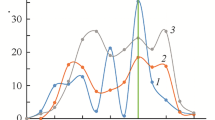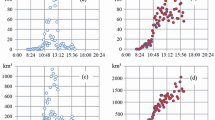Abstract—
The aim of this work is to summarize the results of the study of the development of a high depth thunderstorm over the waters of the Gulf of Finland. A waterspout was observed under the base of the cloud. Remote sensing methods were used in the study. The general conditions of atmospheric instability, microphysical and electrical characteristics of the cloud are considered. Cloud microphysics and the relation with lightning frequency are discussed. High correlation was discovered between the frequency of lightning discharges and the supercooled volume of the cloud, as well as the precipitation flux.


Similar content being viewed by others
REFERENCES
A. A. Sin’kevich, V. B. Popov, Yu. P. Mikhailovskii, M. L. Toropova, Yu. A. Dovgalyuk, N. E. Veremei, and D. S. Starykh, “Characteristics of cumulonimbus with waterspout over Ladoga Lake from remote measurements,” Atmos. Ocean. Opt. 33 (4), 387–392 (2020).
C. Liu, D. J. Cecil, E. J. Zipser, K. Kronfeld, and R. Robertson, “Relationships between lightning flash rates and radar reflectivity vertical structures in thunderstorms over the tropics and subtropics,” J. Geophys. Res. 117 (D6), 19 (2012).
Yu. P. Mikhailovskii, A. A. Sin’kevich, S. D. Pavar, V. Gopalakrishnan, Yu. A. Dovgalyuk, N. E. Veremei, E. V. Bogdanov, A. B. Kurov, A. Kh. Adzhiev, A. M. Malkarova, and A. M. Abshaev, “Investigations of the development of thunderstorm with hail. Part 2. Analysis of methods for the forecast and diagnosis of the electrical properties of clouds,” Rus. Meteorol. Hydrol. 42 (6), 377–387 (2017).
A. T. Pessi and S. Businger, “Relationships among lightning, precipitation, and hydrometeor characteristics over the North Pacific Ocean,” J. Appl. Meteorol. Climatol. 48 (4), 833–848 (2009).
R. W. Armstrong and J. G. Glenn, “Electrical role for severe storm tornadogenesis (and modification),” J. Climatol. Weath. Forecast 3 (2015).
V. L. Natyaganov and S. A. Maslov, “Electromagnetic mechanisms of forming a tornado-like whirlwind,” Moscow University Mechan. Bull. 69 (2), 29–34 (2014).
S. A. Maslov, “Effect of the atmospheric electric field under a thundercloud on tornado funnel formation,” Moscow University Mechan. Bull. 72 (1), 23–27 (2017).
O. A. Sinkevich, S. A. Maslov, and N. G. Gusein-Zadec, “Role of electric discharges in the generation of atmospheric vortices,” Plasma Phys. Rep. 43 (2), 232–252 (2017).
M. Sioutas, W. Szilagyi, and A. Keul, “Waterspout outbreaks over areas of Europe and North America: Environment and predictability,” Atmos. Res 123, 167–179 (2013).
A. A. Sin’kevich, Yu. P. Mikhailovskii, S. Yu. Matrosov, V. B. Popov, V. S. Snegurov, A. V. Snegurov, Yu. A. Dovgalyuk, and N. E. Veremei, “Relationships between the structure of convective clouds and lightning frequency derived from radiophysical measurements,” Rus. Meteorol. Hydrol. 44 (6), 394–403 (2019).
L. B. Rudneva and A. A. Sin’kevich, “Estimation of the geometrical thickness of a layer which forms black body radiation in clouds of different shapes,” Tr. GGO. Is. 448, 76–85 (1981).
R. Randriamampianina, J. Nagy, T. Balogh, and J. Kerenyi, “Determination of cloud top height using meteorological satellite and radar data,” Phys. Chem. Earth Part B 25, 1103–1106 (2013).
A. A. Sin’kevich, V. B. Popov, I. A. Tarabukin, E. V. Dorofeev, Yu. A. Dovgalyuk, N. E. Veremei, Yu. P. Mikhailovskii, V. S. Snegurov, and A. V. Snegurov, “Changes in Cu characteristics and precipitation during Cu merging,” Rus. Meteorol. Hydrol. 43 (8), 506–515 (2018).
B. D. Lee, B. F. Jewett, and R. B. Wilhelmson, “The 19 April 1996 Illinois tornado outbreak. Part II: Cell mergers and associated tornado incidence,” Weath. Forecast 21, 449–464 (2006).
J. Wurman, Y. Richardson, C. Alexander, S. Weygandt, and P. F. Zhang, “Dual-doppler and single-doppler analysis of a tornadic storm undergoing mergers and repeated tornadogenesis,” Mon. Weather Rev. 135, 736–758 (2007).
M. R. Kumjian, “Principles and applications of dual-polarization weather radar. Part I: Description of the polarimetric radar variables,” J. Operat. Meteor. 1 (19), 226–242 (2013).
A. A. Sin’kevich and Yu. A. Dovgalyuk, “Corona discharge in Clouds,” Izv. Vyssh. Ucheb. Zaved. Radiofiz. 56 (11-12), 908–919 (2013).
ACKNOWLEDGMENTS
The authors of the article express their gratitude to Alina Sarkisova for the video files showing a waterspout (link: https://www.instagram.com/p/BmYmsqkFTNl/).
Funding
The study was financially supported by the Russian Science Foundation (grant no. 18-55-80020).
Author information
Authors and Affiliations
Corresponding author
Ethics declarations
The authors declare that they have no conflict of interest.
Rights and permissions
About this article
Cite this article
Sin’kevich, A.A., Mikhailovskiy, Y.P., Toropova, M.L. et al. Thunderstorm with Waterspout Structure and the Dependence Lightning Frequency on its Characteristics. Atmos Ocean Opt 33, 645–649 (2020). https://doi.org/10.1134/S1024856020060226
Received:
Revised:
Accepted:
Published:
Issue Date:
DOI: https://doi.org/10.1134/S1024856020060226




